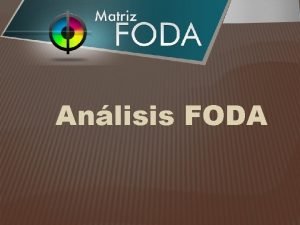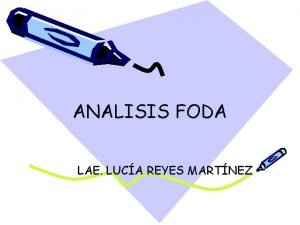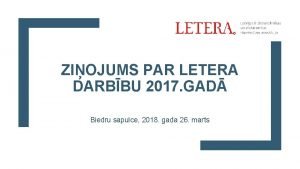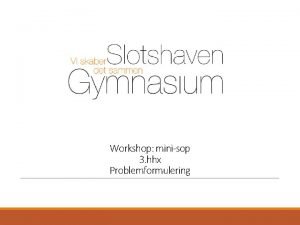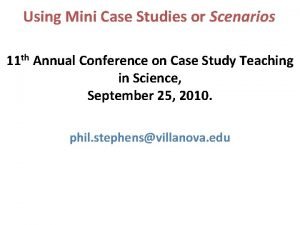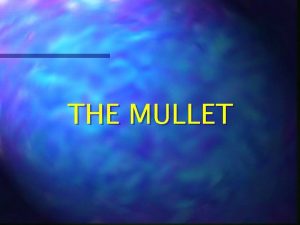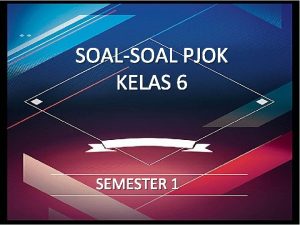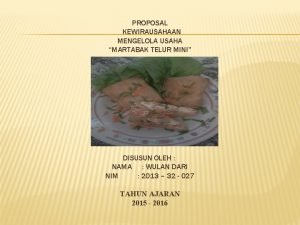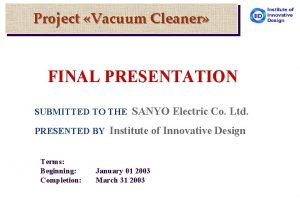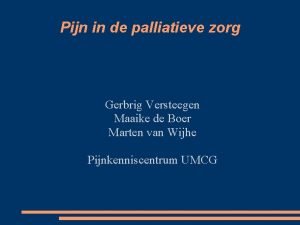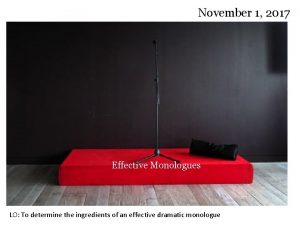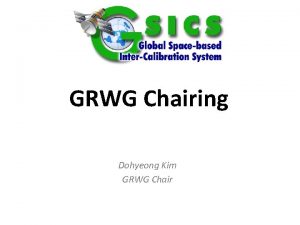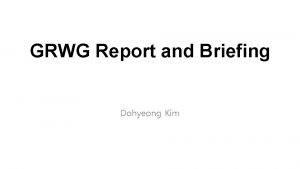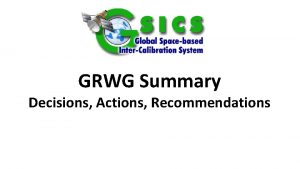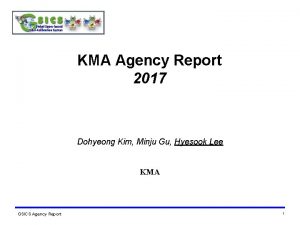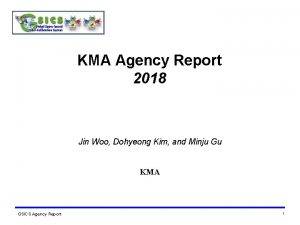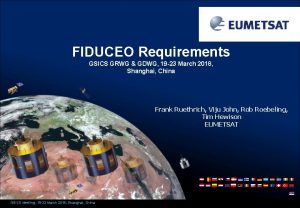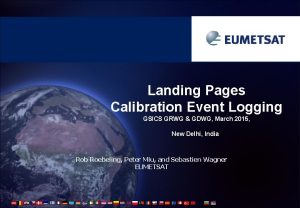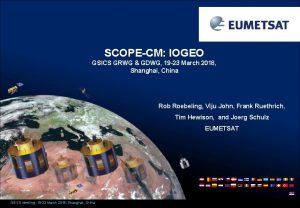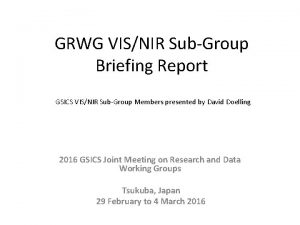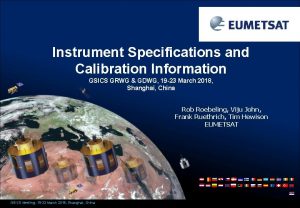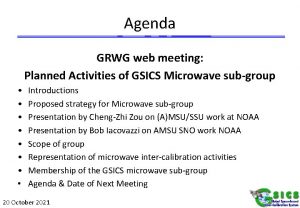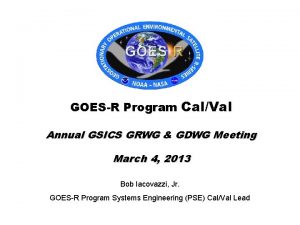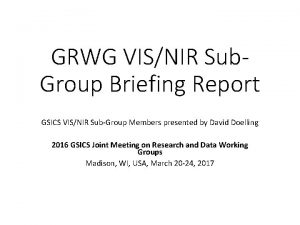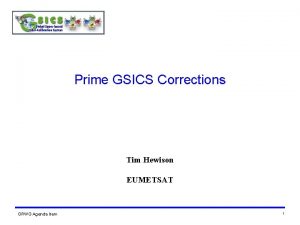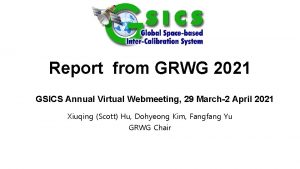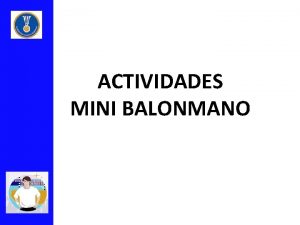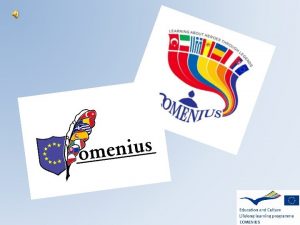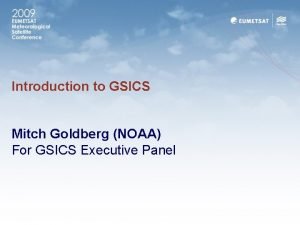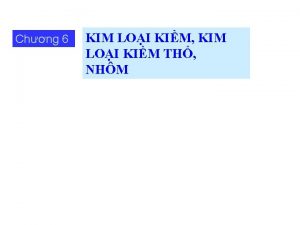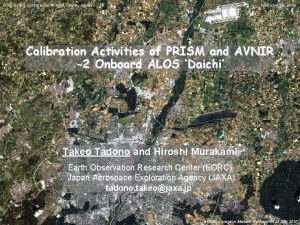Introduction to Mini Conference GSICS Dohyeong Kim GRWG





















- Slides: 21

Introduction to Mini Conference & GSICS Dohyeong Kim GRWG Chair

Overview of GSICS 2

Background of GSICS The Global Space-based Inter-Calibration System (GSICS) : • initiated in 2005 by the WMO and the CGMS • was recognized in 2009 -2011 as a Pilot Project in the Demonstration Phase of the WMO Integrated Global Observing System(WIGOS) GCOS Satellite Data Consistent Calibrated observations GSICS Essential Climate Variables User & Organizations SCOPE-CM 3 dohy Satellites & Sensors

GSICS? § § Space-based observations from various satellite missions must be precisely calibrated with similar methods against common references Poor or inhomogeneous calibration results in degraded performance and lower benefits CGMS members are collaborating within GSICS to develop and apply “best practices” for homogeneous calibration What is GSICS? § ensures consistent calibration of satellite measurements and tie the measurements to SI reference standards § defines and implements procedures for operational, in-orbit satellite intercalibration; § relates the measurements of one instrument to those of a reference instrument with a stated uncertainty. § The overlapping records of two satellite instruments can be compared once a number of effects, such as diurnal cycle, are taken into account. § GSICS inter-calibration allows biases to be removed among satellite measurements. Scope of GSICS? § § coordinates the systematic generation to correct the individual calibration(Level 1) a range of activities related to: ‒ Instrument Level 1 data monitoring ‒ comparison with references ‒ routine generation of corrections in near real-time ‒ provision of algorithms enabling recalibration of archived data ‒ traceability to absolute calibration standards ‒ prelaunch instrument characterization ‒ post-launch instrument validation ‒ documentation on state-of-the-art calibration techniques 4 dohy § Why GSICS?

Who benefits from GSICS ? Satellite operators ‒ • Satellite data users Sharing development effort and ‒ Improved calibration resources (calibration references, ‒ Interoperability through inter- datasets, software tools) ‒ Capacity building (best practices for calibration ‒ instrument monitoring, traceability, sensor comparison and correction) ‒ understanding ‒ Improved instrument assessment, faster identification and correction of anomalies, facilitating commissioning Assessments, reports, for better Algorithms enabling to reprocess data records ‒ GSICS leverages the value of individual missions and operation ‒ Interoperability within the CGMS constellation 5 dohy •

Evolving scope of GSICS • Started with IR calibration corrections (GEO-LEO) • Continued with VIS/NIR domain • Now addressing also the UV and MW domains • Started with Near Real-Time correction functions • Added Re-analysis corrections 6 dohy • Considering now a wider variety of deliverables depending on user requirements

GSICS Services and Tools General information services • • GSICS portal maintained by WMO (http: //gsics. wmo. int) GCC website maintained by the GSICS Coordination Center GSICS related websites maintained by each member agency GSICS User Messaging Service managed by the GCC GSICS Product Catalogue GSICS Quarterly newsletter GSICS User Workshop GSICS Wiki providing access to technical documentation (ATDB of each product and recording presentations from the GRWG and GDWG meetings) Specific tools 7 dohy • GSICS Data and Products Servers (at EUMETSAT, NOAA, CMA) • GSICS product generation framework and products format checker • GSICS Implementation of the ROLO Model (GIRO) lunar calibration software and associated GSICS Lunar Observation Dataset • Various software tools(Bias plotting tool)

GSICS deliverables Core GSICS inter-calibration products Near Real Time corrections Instrument behaviour assessment Instrument correction algorithms Monitored instrument Time–centered corrections Users Science resources Solar & lunar spectra Target characteristics Calibration datasets etc. Spectroscopy database, RTM Standards & procedures References (benchmarks) Metadata & Data Formats Standard vocabulary Procedures etc. GSICS tools SNO matchup Bias monitoring Ray matching Plotting, readers etc. Registration, messaging Product catalogue Data servers wiki, website Documentation info, etc. User services 8 dohy Bias adjustment sequences(archive)

GSICS Members WMO EUMETSAT ROSHYDROMET CNES USGS/NOAA NASA/NIST KMA CMA JMA/JAXA IMD/ISRO Obs. ESA, CEOS(WGCV) ASSO. GPM X-cal 9 dohy 14 Members Worldwide

GSICS Structure CGMS satellite operators CGMS satellite operators WMO GSICS Exec Panel GSICS Research Working Group UV Sub-Group VIS/NIR Sub-Group WGCV ACSG WGCV IVOS GSICS Data Working Group IR Sub-Group Microwave Sub -Group WGCV MWSG GPM X-CAL 10 dohy GSICS Coordination Center

Highlight of GSICS activities

IR Product Development within GSICS (IR) 12 dohy v GEO-LEO IR hyperspectral – Progress existing products to Operational Status – Promote new products to Demonstration Status – Application of Prime GSICS Correction concept • To merge multiple reference instruments • To allow corrections to cover diurnal cycle v Scope potential new GSICS products/deliverables – Alternative inter-calibration algorithms – Retrieved SRFs – GEO-GEO inter-calibration (part of GEO-ring) – LEO-LEO inter-calibration v Traceability of Reference Instruments – Plans for TANSO-FTS/2 & CLARREO – GSICS IR Reference Sensor Traceability and Uncertainty Report

DCC calibration Status (VIS/NIR) v Started in 2014 – NASA Langley provided all GPRCs verification data to validate the proper implementation according to ATBD submitted in 2011 v The DCC method has been implemented by all GPRCs by 2015 and reported on their status and issues of the implementation 13 dohy v The DCC methodology provides excellent estimate of the relative degradation of the monitored instrument, however the GEO domain specific DCC methodology noise can be reduced by adjusting DCC methodology components as needed 1) DCC BRDF – KMA has also evaluated RTM based method developed by SNU – CNES has defined the more Lambertian part of the BRDF 2) DCC deseasonalization – NOAA, EUMETSAT, CMA have developed methods 3) DCC statistics and identification (to provide sufficient sampling)

Improving the lunar reference v Improvement of the reference standard for lunar calibration ‒ to improve absolute accuracy ‒ to reduce residual geometry dependencies (phase, librations) v The reference irradiance is generated for each observation of the Moon taken by an instrument by computing the lunar model(ROLO, GIRO) 14 dohy v Requirements for Absolute Lunar Calibration Reference ‒ reprocessing the ROLO telescope dataset using new algorithms ‒ incorporating reliable new observational data e. g. PLEIADES ‒ lunar radiometry e. g. SNPP VIIRS ‒ collecting new radiometric measurements of the Moon ‒ requirements: • high-accuracy, with traceability to SI • full spectral coverage at moderate spectral resolution • photometric geometry coverage (phase and librations) sufficient for high-precision modeling

Operational coordination GSICS Procedure for Product Acceptance (based on QA 4 EO, a series of reviews over period of ~1. 5 yr) Development Phase GOES-sounder, FY 2 C-E Demonstration Phase EUM (MET-7), JMA(Himawari-8), KMA(COMS), ISRO(INSAT-3 D) Pre-operational Phase GOES-13, 15 (NRT&RAC). GOES-11, 12 (NRT) Operational Phase 15 dohy EUMETSAT(Meteosat 8 -11/IASI)

Where to get the data? v GSICS Bias Monitoring ü Hosted on websites of GSICS Processing & Research Centres (GPRCs) http: //gsics. tools. eumetsat. int/plotter/ v GSICS Corrections − GSICS Data & Products Servers − THREDDS-based system − Net. CDF format − WMO GTS standard file names − Unidata & CF conventions See gsics. wmo. int for links 16 dohy GTS = Global Telecommunication System CF = Climate and Forecast

Conclusions 17 dohy v GSICS is maturing into a system for generating intercalibration products v suitable for integrating into operational processing v First products have been declared operational v Continuing to develop new inter-calibration products v While cooperating with related activities v To integrate GSICS into WIGOS v To support Architecture for Climate Monitoring from Space v Today: Examples of potential future activities & interactions v Rest of the Week: Focus on development of GSICS deliverables

Mini Conference

Mon am Mini Conference Chair: Peng Zhang 8: 45 Coffee and Registration 9: 00 Peng Zhang/ Lei Ding CMA/ SITP Welcome address 1 a 0: 05 9: 15 Dohyeong Kim Peng Zhang KMA CMA Introduction to Mini Conference & GSICS Agenda, Announcements, etc 1 b 1 c 0: 10 9: 25 Peng Zhang CMA Latest progress of CMA FY-3 D and FY-4 satellite 1 d 0: 20 9: 45 Lei Ding SITP Development of SI-traceable Hyperspectral FTIR instrument 1 e 0: 20 10: 05 Qiang Guo CMA FY-4 A satellite commissioning latest outcome 1 f 0: 20 10: 25 John Fullbright NOAA (Remote) GOES-16 calibration and validation 1 g 0: 20 10: 45 Zhongdong Yang CMA Post-launch test progress of FY-3 D 1 h 0: 20 11: 05 Coffee break 0: 20 11: 25 Changyong Cao/ Lin lin NOAA/ NOAA Affiliate NOAA-20 Imager/Sounder SDR Maturity and Collaboration with FY 3 D through GSICS 1 i 0: 20 11: 45 Feng Jiang SITP Solar band SI-traceable demonstration instrument 1 j 0: 20 12: 05 Yanmeng Bi/ Zhongdong Yang CMA Tansat/ACGS inflight calibration and validation 1 k 0: 20 12: 25 Dekui Yin/ Yipeng Zhang SITP TG-2 Multi-Angle Polarization Imager Calibration and evaluation 1 l 0: 20

Notes to speakers v Please follow file naming convention: 1 a_Hewison_Introduction. pptx/pdf/ppt v Presentations will be uploaded to the GSICS Wiki ü Unless you tell me not to v All slots are strictly 20 min v Please leave at least 5 min for questions v The chair will give a warning after 13 min 20 dohy Thank you!

Thank you!
 Estrategia fo maxi maxi
Estrategia fo maxi maxi Estrategia da mini-mini ejemplo
Estrategia da mini-mini ejemplo Estrategia maxi maxi ejemplos
Estrategia maxi maxi ejemplos Body paragraph structure
Body paragraph structure Gads mini mart
Gads mini mart Mini saga writing
Mini saga writing Mini saga
Mini saga Dho eksempel hhx
Dho eksempel hhx Mini vidas parts
Mini vidas parts Mini case study examples
Mini case study examples Mini-cursus klantcontact
Mini-cursus klantcontact Skullet definition
Skullet definition Mini projet exemple
Mini projet exemple Gerak mengumpan dilakukan dengan
Gerak mengumpan dilakukan dengan Background essay questions
Background essay questions Reign of terror mini q
Reign of terror mini q Proposal martabak
Proposal martabak Mini vacuum cleaner project presentation
Mini vacuum cleaner project presentation Mini-cursus gastgerichtheid
Mini-cursus gastgerichtheid Mini essay structure
Mini essay structure Syndrome monologue
Syndrome monologue Newsfeed defenders
Newsfeed defenders
